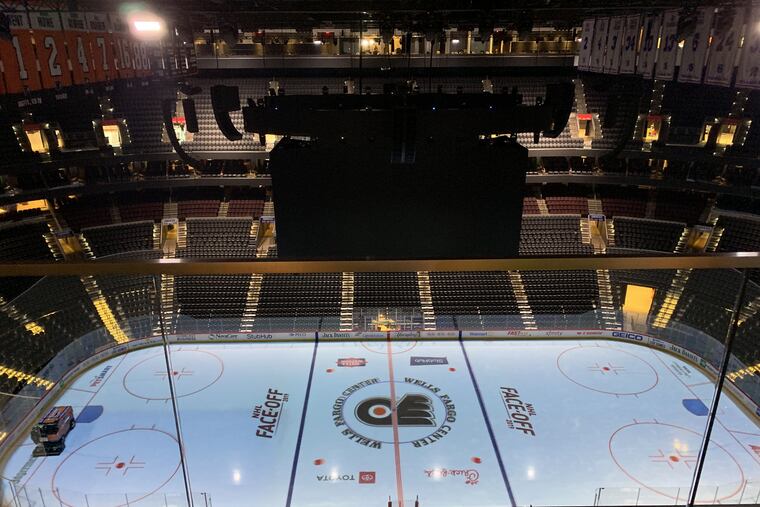Flyers’ overall attendance is not at capacity, but new area at Wells Fargo Center has become popular with fans — especially millennials
The Assembly Room, a new 23,000-square-foot section at the arena, has one of the NHL’s lowest ticket prices — $25.

Flyers fans haven’t seen their team win a playoff series in seven years, so when the organization raised ticket prices to coincide with an impressive $265 million renovation project to the Wells Fargo Center this season, there were the predictable complaints.
But you don’t hear complaints about the Assembly Room, a new 23,000-square-foot section at the arena that has one of the NHL’s lowest ticket prices — $25, with no additional fees if purchased at the Wells Fargo Center box office.
The standing-room-only ticket offers a very good view of the action from goal line to goal line, along with huge areas to congregate or sit on leather couches or comfortable seats you would find in an upscale living room.
There are also two eateries and two bars, where fans can purchase specialized drinks and unique food, and screens where people can watch the game action if they don’t like their spot that overlooks the ice.
These standing-only tickets — there are 700 available for each game — were sold out for five of the team’s first eight home games and are selling at a brisk rate for upcoming games according Valerie Camillo, president of business operations for the Flyers and the Wells Fargo Center.
Based on the “eye test,” the Assembly Room has become especially popular with millennials, she said.
“More than anything, we are seeing a significant amount of fans who have never purchased Flyers tickets before, which is what we hoped for during the design process,” Camillo said, adding the Assembly Room was viewed as an “opportunity to introduce Flyers hockey to a new generation of fans who have never experienced the game live.”
Despite a 5-1-2 record at the Wells Fargo Center to start the season, the Flyers’ home attendance is in the bottom third of the league when the percentage of seats filled is calculated.
Don’t blame it on the Assembly Room, an area previously used for suites that hosted huge groups.
Camillo said the Flyers could have charged a “lot more” for the tickets but wanted to offer a low-cost alternative.
Named for the Assembly Room found inside Independence Hall, the area has a historic Philadelphia feel with its unusual paintings, four fireplaces, and upscale furnishings. The paintings and murals, featuring original works by Nathan Loda and Ali Williams, respectively, have a Spirit of ’76 theme – they depict important figures from Philadelphia’s history with surprising, modern twists.
Currently, for instance, paintings of Benjamin Franklin and Betsy Ross are displayed, with how they would look if they were alive and young today.
As for the view of the ice, “the hard-core hockey fan is watching the game from the same vantage point as (general manager) Chuck Fletcher and his staff,” Camillo said.
The casual fan, she said, gets to watch a game and have a “more social experience. I also love how authentically Philadelphia it feels. Every last detail was taken into account.”
Earlier this month, the Flyers announced they would hold 200 Assembly Room tickets to be released the morning of each home game; they refer to it as the “Assembly Room Last Call” program, giving fans who want to make a last-minute decision a chance to purchase tickets. Those tickets are released at 9 a.m. every game day, and are available at the Wells Fargo Center or online at the team’s website.
The Assembly Room releases its tickets two months into the future.
Heading into Saturday’s home game against the New York Islanders, the Flyers were 22nd out of 31 NHL teams in home attendance based on percentage of its capacity. Their average home attendance per game was 17,700, which was 91.7 per its capacity, according to ESPN. Winnipeg was No. 1, filling 123.9 percent of its capacity, and Ottawa (58.3 percent) was last.
Eight teams were filled at 100 percent of its capacity or higher: Winnipeg, Chicago, Vegas, Toronto, Nashville, Pittsburgh, Washington, and St. Louis, while Tampa Bay was at 99.5 percent.